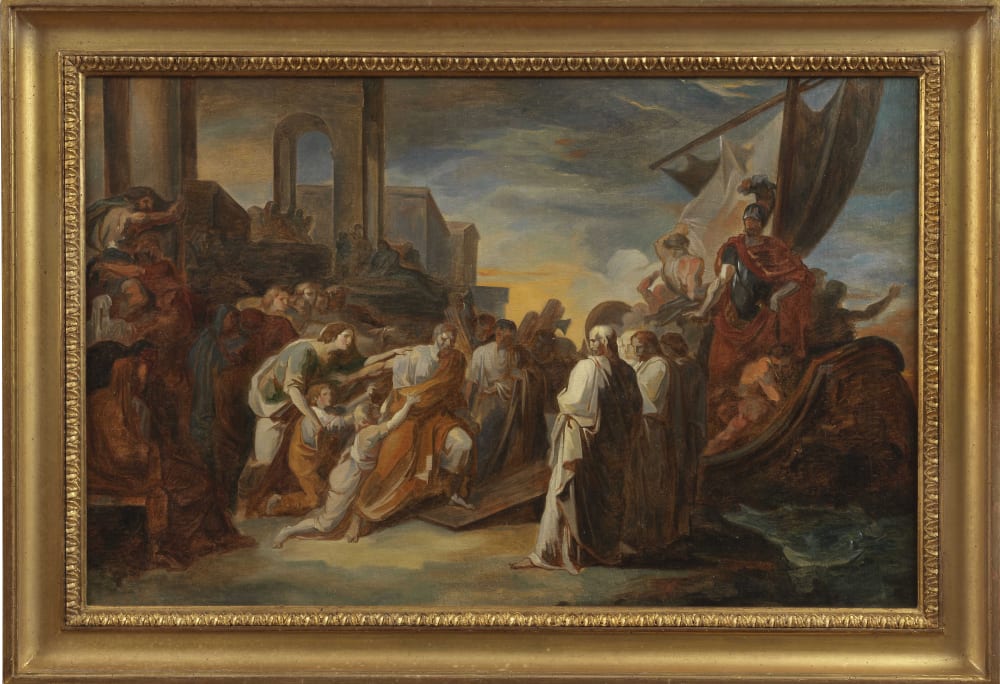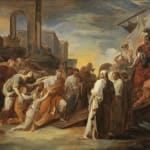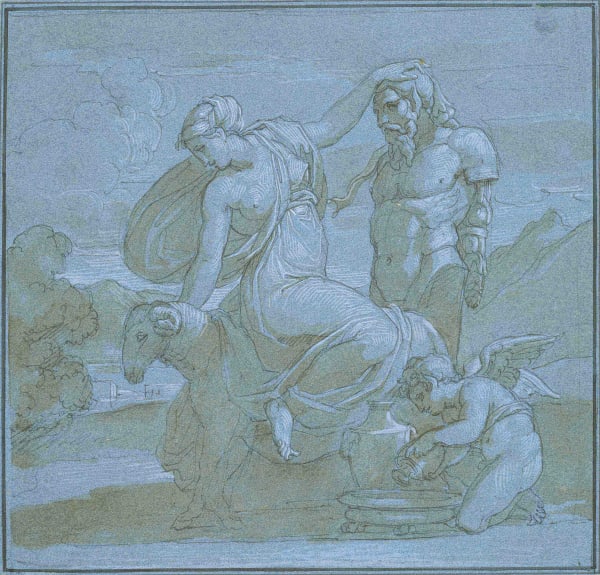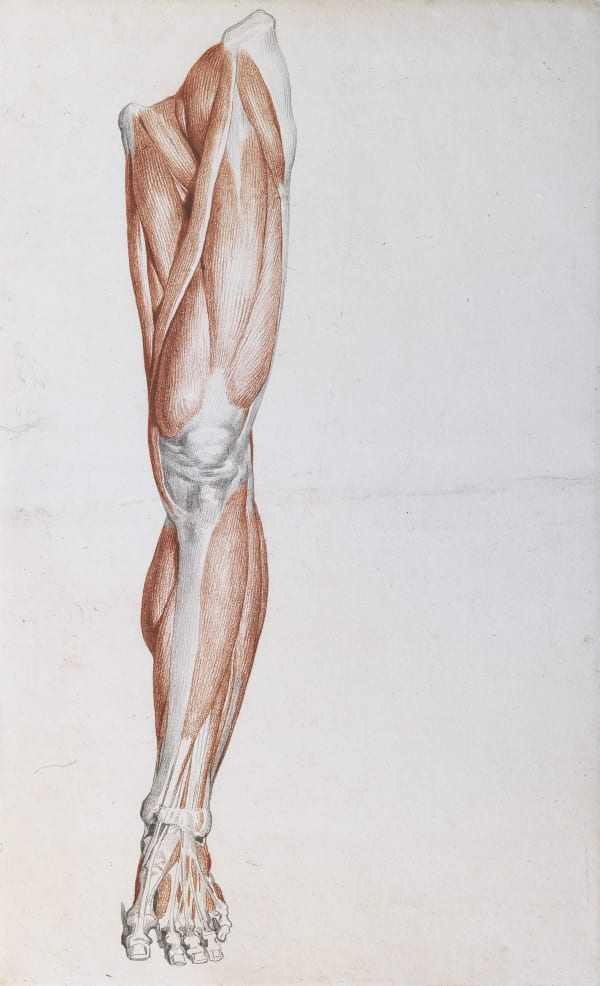


VINCENZO CAMUCCINI ROME, 1771-1844
Provenance
Cantalupo in Sabina, Palazzo Camuccini, the collection of Baron Vincenzo Camuccini.
Exhibitions
1978, Roma, Galleria Nazionale d’Arte Moderna, Vincenzo Camuccini (1771-1844). Bozzetti e disegni dallo studio dell’artista, n. 153.
Literature
This small canvas is a preparatory sketch for one of the most successful commissions that Vincenzo Camuccini was to produce in the fullness of his maturity. It depicts the departure of Marcus Attilius Regulus for Carthage, an episode in Roman history that underscores the heroism of the city's ancient generals. The story told by Livy and sung by Horace but of questionable historical accuracy, is set during the First Punic War. Consul Marcus Attilius Regulus, who is being held prisoner by the Carthaginians, is released so that he can persuade the Romans to enter into peace negotiations. The agreement is that if Regulus fails in the attempt, he will return to Carthage to be put to death. When he arrives in Rome, however, he informs his fellow citizens of the Carthaginians' critical circumstances and urges them to persevere in the battle because victory is within their grasp. Then, keeping faith with his word to the enemy, he returns to Carthage to meet certain death that, the legend adds, was only inflicted on him after he had suffered the cruellest torture.
Camuccini tackled the theme of Attilius Regulus in 1824. A comparison of the autograph lists in which the painter recorded his every work with several different printed sources of the period shows that Camuccini produced fully three versions of the picture intended for an international clientele the highest rank, to which we should add a further replica produced "for the workshop" (Hiesinger, p. 316; Piantoni, pp. 72-73). The only one of these four paintings known to us is the one that stayed behind in the artist's workshop, because it was bequeathed to the Museo di Roma in Palazzo Braschi by one of the artist's heirs in 1989 (Acquisti e doni nei musei comunali, p. 47, n. 22; not on display). The other three versions, unpublished to date, were commissioned from Camuccini by members of the most prestigious European aristocracy of the day: Russian Prince Ivan Baryatinsky, Polish Countess Klementyna Ostrowska, née Sanguszko, and the Duke of Blacas, a well-known collector of antiquities and a protector and patron of artists. The Attilius Regulus that belonged to Blacas is still in his family's castle of Ussé on the Loire, while the whereabouts of the other two are unknown. It is not clear which of the three pictures was the first one to have been commissioned from Camuccini, the sources in that connection appearing to be at odds with one another in that connection. In my view, in any event, the first version is likely to have been the one painted for Prince Baryatinsky, as we learn from the caption to an engraving made by Domenico Marchetti two years later, in 1826 (Lovery, pp. 440-42). The completion of this painting – which was of a considerable size, measuring fully 16 x 22 spans (approximately 3.5 x 5 metres; cf. De' Rossi, pp. 3-4) – must, however, have been preceded by the completion of a smaller version of the work for the Duke of Blacas. Both works, in any event, were certainly finished in the first half of 1824, the Blacas version seemingly before the large Baryatinsky canvas (Hiesinger, p. 316). In the Russian prince's collection, the picture was apparently intended to act as a companion piece to the Death of Camilla by the Italo-Russian artist Fyodor Bruni, which is now in the State Russian Museum in St. Petersburg.
The replica for the Countess Ostrowska, which Marchetti fails to mention, is therefore likely to have been a later version (Hiesinger, p. 316). While it is recorded both in one of Camuccini's autograph inventories and by (Falconieri, p. 114), it is not mentioned in contemporary sources. Falconieri, however, also mentions a study given to Signora Pradel (Falconieri, p. 262).
The sketch under discussion here is unquestionably a preparatory study for the work and must have been made in an early stage of the painting's creation. This, because a comparison with the picture now in Palazzo Braschi shows that, while the basic idea behind the composition is unchanged, numerous changes were made in the final version. The painting, set on the banks of the Tiber, depicts Marcus Attilius Regulus as he fearlessly prepares to board the ship that was to take him back to Africa, heroically pushing his wife and children away as they endeavour to prevent him from leaving. The dignitaries and the people of Rome look on almost like a chorus, displaying a broad range of appropriate sentiments such as consternation, despair and admiration. In the background, the architecture is restrained and sober as befits the Republican era. Compared to the preparatory sketch, the final painting shows a reduction in the overall number of figures, and those figures are brought closer into the foreground in an attempt to achieve a more monumental and solemn effect. The drawings of drapery for the same composition, shown in this gallery in 2003 (Antonacci, n.14 and n.15), belong to a far more advanced phase in the development of the composition.
Historical subjects and, in particular, exempla virtutis based on Roman history were one of the main genres on which Camuccini focussed right from the start of his artistic career, with such early commissions as the Death of Caesar and the later Death of Virginia commissioned from him by the Earl of Bristol towards the end of the 18th century. Such themes had catalysed the attention of the Neo-Classical artists in the final decades of the 18th century, starting with Jacques-Louis David whose extremely popular Oath of the Horatii, painted in 1784, might be said to have been the prototype for this genre of painting. Camuccini's take on the genre was no less solemn than David's, yet at the same time it showed more of a narrative approach, faithfully illustrating the event in accordance with the dictates of ancient sculpture, affording due emphasis to the leading figure around whom the secondary figures revolve, against an unerringly accurate backdrop that was the product of meticulous historical research. Camuccini assigns a key role to the echoes of the great models of the classical tradition, both ancient and modern, which he studied in such great depth during his formative years that they had become part and parcel of his artistic DNA. We can see an example of this, in the finished work, in the figure of a sailor intent on casting off on the far right of the painting. The figure is clearly inspired by the celebrated statue of the so-called Arrotino, or Blade-Sharpener, in the Uffizi.
Federica Giacomini
-
 VINCENZO CAMUCCINIDorsal region, shoulder, arm, forearm and hand
VINCENZO CAMUCCINIDorsal region, shoulder, arm, forearm and hand -
 VINCENZO CAMUCCINIInebriated Bacchante
VINCENZO CAMUCCINIInebriated Bacchante -
 VINCENZO CAMUCCINIAppius Claudius. Sketch for the left-hand side of 'Death of Virginia', c. 1802
VINCENZO CAMUCCINIAppius Claudius. Sketch for the left-hand side of 'Death of Virginia', c. 1802 -
 VINCENZO CAMUCCINIThigh, knee, leg and foot
VINCENZO CAMUCCINIThigh, knee, leg and foot -
 VINCENZO CAMUCCINIHoratius Cocles, 1813 - 1815
VINCENZO CAMUCCINIHoratius Cocles, 1813 - 1815 -
 VINCENZO CAMUCCINIPortrait of the miniaturist August Grahl, 1828 c.
VINCENZO CAMUCCINIPortrait of the miniaturist August Grahl, 1828 c.
Join the mailing list
Subscribe to our newsletter to receive all the news about exhibitions, fairs and new acquisitions!







